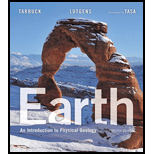Solutions for Earth: An Introduction to Physical Geology Plus Mastering Geology with Pearson eText - Access Card Package (12th Edition)
Browse All Chapters of This Textbook
Book Details
For all introductory physical geology courses.
This package includes MasteringGeology ™.
Learning Objective-driven textbook, using augmented reality to bring geology to life
With its strong readability and engaging, instructive illustrations, this trusted bestseller returns with a hybrid and streamlined focus on core principles. Earth: An Introduction to Physical Geology maintains a learning objective-driven approach throughout each chapter: The text provides students with a structured learning path, tied to learning objectives with opportunities for students to demonstrate their understanding at the end of each section. The authors’ emphasis on currency and relevance includes the latest thinking in the field, particularly in the dynamic area of plate tectonics.
The Twelfth Edition, Pearson Science’s first augmented reality, hybrid textbook, uses the BouncePages image recognition app (FREE on both iOS and Android stores) to connect students’ digital devices to the print textbook, enhancing their reading and learning experience. Tarbuck/Lutgens’s innovative SmartFigures feature has been expanded, adding new digital content via Project Condor, Mobile Field Trips by Michael Collier, Animated Figures, and additional tutorial videos from Callan Bentley.This edition also includes MasteringGeology, the most complete, easy-to-use, engaging tutorial and assessment tool available.
Sample Solutions for this Textbook
We offer sample solutions for Earth: An Introduction to Physical Geology Plus Mastering Geology with Pearson eText - Access Card Package (12th Edition) homework problems. See examples below:
More Editions of This Book
Corresponding editions of this textbook are also available below:
